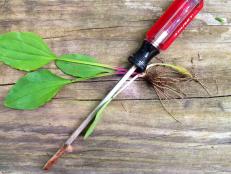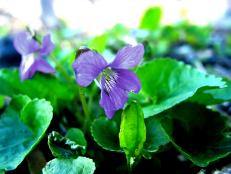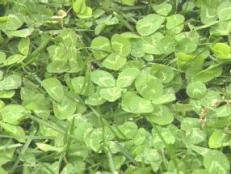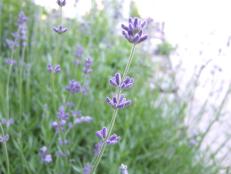Edible Chickweed: Here Chicky, Chicky, Chickweed
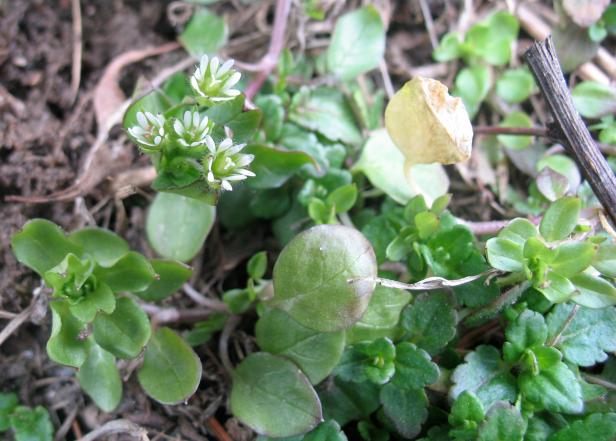
Foraging expert Steve Brill has shared his foraging wisdom at schools, museums, parks departments, environmental organizations, and with scout troops since 1982. He’s written three books and an app, stars in a DVD and maintains a website at Wildman Steve Brill.
COMMON CHICKWEED (Stellaria media) and STAR CHICKWEED (S. pubera)
Description
This small, sprawling, European annual's slender stem bears a distinctive row of fine white hairs, and tiny, smooth-edged -- spade-shaped to oval -- opposite leaves. Unlike some other ground-hugging plants, it never forms a basal rosette. Common chickweed's leaves have short leaf stalks, while star chickweed has stalkless leaves.
Tiny white flowers grow at the tips of the plants, with five petals so deeply split that they look like 10. Five green sepals surround the petals.
Tiny yellow-brown, oval-shaped seeds fall out of tiny ovate, stalked capsules before the plant dies.
Seasons
Chickweed is in season all year, even growing in the winter any time it's above freezing, but it's at its best in early spring and mid- to late- fall.
Habitat
Chickweed grows in lawns, meadows, gardens and disturbed areas, in full sunlight and partial shade. In very cold weather, look for it along sun-heated walls with southern exposure, where it thrives in the milder microhabitat.
Range
Various chickweed species, all edible, grow throughout North America.
Harvesting
Look around for where this plant is the most plentiful before collecting. One spot can have some chickweed mixed with grass, which you'll need to separate out, whereas other places may have dense mats of pure chickweed. And collect where it's thriving, young and bright green, before it begins to go to seed, becomes light green and gets stringy.
Grab and bag the entire plant, avoiding any with yellowed leaves or discolored stems, or clip with shears, a knife or scissors.
Food Preparation
The whole plant, except the roots, is delicious. Eaten raw, it tastes like corn-on-the-cob, or like cornsilk. Cooked, it's more like spinach. Always chop the entire plant, except the roots, into bite-sized pieces before using it.
A salad vegetable and pot herb par excellence, it's also great in sandwiches. Use it like sprouts or in Middle Eastern recipes, with hummus in pita bread. It's wonderful steamed or added to soups, stews and casseroles. You can also sauté it. It cooks in about 5 minutes. Take care not to overcook it.
Nutrition
Chickweed is a nutritional powerhouse, providing vitamins C, A, D, folic acid, riboflavin, niacin and thiamine, as well as the minerals calcium, magnesium, potassium, manganese, zinc, iron, phosphorus, sodium, copper and silica.
Medicinal Uses
An infusion of the above-ground parts has been used as a safe, gentle diuretic, and the chopped plant has been applied topically to various skin sores and irritations for hundreds of years (you'd think after all that time, the sores would finally heal!)
Back in the day, while doctors were bleeding their patients -- sometimes to death -- herbalists gave chickweed to convalescents after serious illnesses to rebuild their strength before opportunistic infections could cause a relapse. Turns out chickweed is loaded with more vitamins and minerals than a health food store, so it probably replaced the nutrients the immune system needs, which had been depleted during the illness.
Poisonous Lookalikes
Prostrate spurge (Euphorbia supina) and spotted spurge (E. maculata), which grow close to the ground and have opposite leaves, look a little like chickweed, and they can grow side by side with chickweed. But spurge exudes an acrid, white, milky sap when cut. Chickweed doesn't. Spurge lacks chickweed's row of tiny white hairs growing along the stem, and it grows in rosettes rather than forming mats. Spurge, which contains diterpene esters, causes nausea, vomiting, and diarrhea when eaten, or redness, swelling, blisters after contact with the skin and exposure to sunlight.
Scarlet pimpernel (Anagallis arvensis) is a small plant with opposite leaves that grows along the ground, but it lacks chickweed's row of fine hairs on the stem, and it has a scarlet flower. It contains a triterpenoid saponin and a glycoside (cyclamine) that cause constipation, skin inflammation, staggering, headache, kidney problems and nausea. Scarlet Pimpernel is especially dangerous to the French, as anyone who's read the book or seen the movie knows!
Other Similar Plants
Other less common species of chickweed, also edible, grow throughout the North America. Mouse-ear chickweed (Cerastium vulgatum), also with opposite leaves, is hairy all over. It's good cooked, but you won't enjoy it raw unless you like eating hairy food!
Doorweed (Polygonum aviculare) looks a little like chickweed because it grows along the ground, sometimes next to chickweed, but its leaves are alternate, not opposite. Unlike chickweed, it grows in a basal rosette. And there's no row of hair on the stems. Instead, the stems are punctuated by joints. The plant isn't poisonous, but with the texture of string, it's not edible.
Chickweed and Chickens
Chickweed gets its name because chickens like it. So this is a plant you should give your friends if they're afraid to try wild foods. They'll definitely love it, because they're chicken!
I once led a tour for grade-school kids on the grounds of their private school in Greenwich, Conn., and we found chickweed. I told the kids how it got its name, and they told me they had an incubator full of newly hatched chicks. We raced into the school and threw them some chickweed. Immediately the chicks started having tugs of war to get as much of the plant as possible!
Chickweed and Vegetable Casserole
Chickweed, mixed with other fresh vegetables and some simple seasonings, is baked to perfection in this easy casserole dish.
2 cups chickweed, chopped
2 large carrots, sliced
1-1/4 cups vegetable stock
1/2 of a daikon, or 1 cup radishes sliced
4 tomatoes, sliced
2 beets, sliced
1 red onion, sliced
6 cloves of garlic, chopped
1/4 cup parsley, chopped
1/4 cup cilantro, chopped
1 teaspoon fennel seed, ground
1 teaspoon rosemary, ground
1/4 teaspoon black pepper, ground
2 tablespoons lemon juice
2 tablespoons olive oil
1 tablespoon teff (a grain available in health food stores) or 1/4 cup quinoa
2 tsp. Vege-Sal or seasoned salt
Mix together all ingredients in a large casserole dish and bake, covered, in a preheated 350º F oven for 1 hour, or until all the vegetables are tender.
Serves 6
Preparation time: 15 minutes
Cooking time: 60 minutes
Editor’s Note: The content of this article is provided for general informational purposes only. Be cautioned that some wild plants can be poisonous, and poisonous plants sometimes resemble edible plants which often grow side by side. It is the responsibility of the reader, or the reader’s parent or guardian, to correctly identify and use the edible plants described. HGTV does not guarantee the accuracy of the content provided in this article and is not liable for any injury resulting from use of any information provided.
This article is not intended as medical advice. Always consult a professional healthcare provider before trying any form of therapy or if you have any questions or concerns about a medical condition. The use of natural products can be toxic if misused, and even when suitably used, certain individuals could have adverse reactions.






